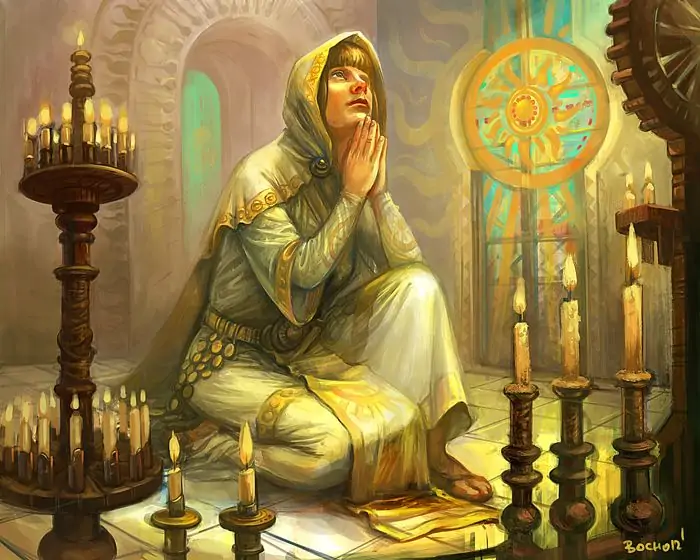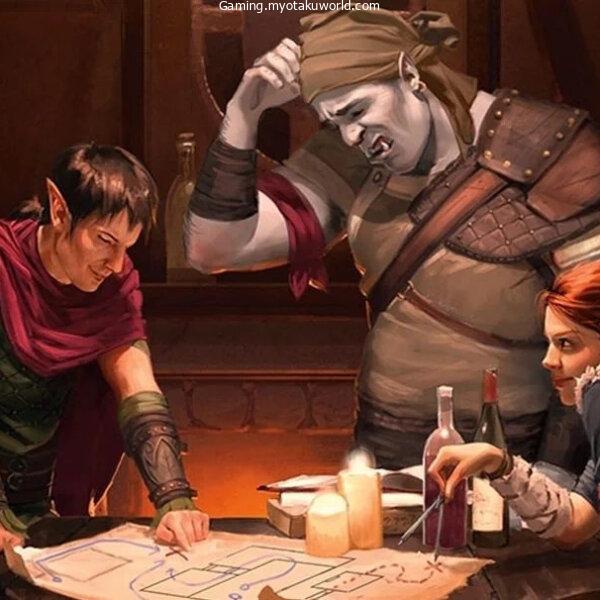People think of weddings, funerals, and other events when they hear the word “ceremony.”
From a Dungeons & Dragons point of view, it was pretty much the same until Xanathar’s Guide to Everything added the Ceremony spell. From then on, the word became a spell, and people talked about how to break the spell.
Since the spell is new, it’s up to the D&D veterans to come up with both a problem and an answer for it.
My trouble is that I don’t know how to use this spell in the best way to get the most out of it. After a lot of thought, the key will be in the next few sections.
So, come with me from Exandria to the Forgotten Realms as we look at what ceremony can do and how to use this D&D spell to its fullest potential.
Let’s start our Ceremony 5e guide by looking at what this magic actually is. Welcome to a Ceremony 5e Guide.
What is Ceremony?
This spell provides a way for those allied with the ethereal to bless others. If your character plays the long religious game, Ceremony might be a good choice for your spell list.
According to Xanathar’s Guide to Everything:
You perform one of several religious ceremonies. When you cast the spell, choose one of the following ceremonies, the target of which must be within 10 feet of you throughout the casting.
The ceremony spell belongs on the lists of Cleric and Paladin. Your character performs one of a few rituals that have different, temporary, positive effects on the target or targets.
Ceremony 5e Stats
| Level | 1 |
| Casting Time | 1 Hour |
| Range/Area | Touch |
| Classes | Cleric, Paladin |
| Components | Verbal, Somatic, Material* |
| Duration | Instantaneous |
| School | Abjuration |
| Attack/Save | Intelligence (Atonement only) |
| Damage/Effect | Buff |
In detail

Ritual Spells can be cast without taking up a spell space, but they take 10 minutes longer to cast. Even though it still uses up the material part, at least the spell spot wasn’t used up.
Assuming you cast it, you need to say what result you want at the start of the cast. What they do is this.
Atonement
The Ceremony of Atonement is used to change a character’s alignment back to how it was before. It says, “You touch a willing creature whose allegiance has changed, and you make a DC 20 Wisdom (Insight) check. If you pass the check, the target goes back to its previous alignment.
These are for people or creatures who have strayed from the right road but might be able to get back on track. In the Exandria Unlimited: Calamity campaign, it was used as an example of how to use it.
The target must agree, and the person who casts the spell must pass an understanding check. If not, the ceremony won’t work, so make sure that the thing you cast this on really wants to go back to how it was.
Bless Water

“Touch one bottle of water to make it holy water.” Since this spell costs 25GP to cast, people were not sure if this language was a mistake or on purpose. The fact that it makes one vial of holy water was used as an argument.
If we look at what the PHB says about holy water on page 152. “As an action, you can splash the contents of this flask onto a creature within 5 feet of you or throw it up to 20 feet, where it will break on impact.
In either case, use the holy water as a makeshift weapon to make a ranged attack against a monster you choose. If the victim is a fiend or an undead, 2d6 radiant damage is done to it.
By following a special ritual, a cleric or knight can make holy water. The process takes 1 hour, costs 25 GP worth of powdered silver, and uses up a 1st-level spell slot.
Taking this into account, it is almost the same to use the holy water rite or to cast Ceremony. So, you might ask, what’s the difference?
Well, you can save one spell slot with Ceremony. Also, you don’t have to be a priest or a paladin to cast it if you learn it some other way.
It also makes holy water bottles that don’t go bad, so if you don’t mind paying 25gp each time, you can make these if you don’t have a temple nearby to buy them from.
Coming of Age

“You touch one young adult creature. For the next 24 hours, whenever the target makes an ability check, it can roll a d4 and add the number it rolls to the ability check. This spell can only help a thing once.”
It’s always nice to get a bonus on a skill check, and it’s even better if it comes before some kind of rite of passage. Ability checks are the most common type of roll that happens outside of battle, so one roll of a D4 could change a result that seemed impossible to change.
The age is a little bit relative, since “young adult” means different things for races with long or short lives. Other than that, Ceremony is exactly what it seems to be.
Dedication
“You touch one humanoid who wishes to be dedicated to your god’s service. For the next 24 hours, whenever the target makes a saving throw, it can roll a d4 and add the number rolled to the save. A creature can benefit from this rite only once.”
It is an interesting ceremony that can basically kickstart a character’s journey into becoming an adventurer. It could turn into a backstory for a paladin or cleric in training as they dedicate themselves to the faith.
With tons of gods in the Forgotten Realms, there are many ways to spin this. You can create a story where cultists induct harmless villagers to their evil god or make this a rite of passage for any would-be paladins.
Funeral Rite

“If you touch one corpse, the target can’t turn into a zombie for seven days, unless you cast a wish spell.”
This works well if your game is about the dead or if your final bad boss is a lich or necromancer. I used this in the remake of the Curse of Strahd game.
My knight was worried that Strahd could make the undead behind us. They stayed hidden for the rest of the campaign, which was a good thing.
It can also be used to make peace with villagers or other NPCs you meet along the way, or as a warning sign if zombies decide to show up. It shows that the enemy can use the Wish magic, which changes the way things are.
Wedding
“You touch adult humanoids who want to get married and be joined together. Each target gets a +2 bonus to AC for the next seven days if they are within 30 feet of each other. A creature can only use this rite again if it has lost its spouse.”
The last ritual on this list is one that gives a stat boost that lasts for about half a year. Even though it only lasts a week, for 25gp, that could come in handy when things get tough. When you combine that with the real happiness of getting married, you get a very happy character.
It’s nice, it’s moving, and it has the most impact of all the effects. As the saying goes, “Love wins.”
What Classes can cast this
Ceremony is an abjuration spell of the first level, but it also belongs to the Divine type of magic. Gods and other beings’ magic.
So, it makes sense that the classes that can cast it are the ones that are most like priests in real life.
Cleric

All priests can use this spell, which makes them the most priestly class. When this spell was made, we no longer have to ask the DM if we can have an impromptu wedding.
Your priest can pray for people in need or bless certain NPCs or trainees of the cloth with this.
That doesn’t mean that only clerics can hold ceremonies, but it does mean that clerics with class levels can lead ceremonies that give other people power.
They can also use the Ritual casting class ability, which lets them do these events without using a spell slot. This is a big help on long days of marching.
Paladin
These people, who are more like crusaders than priests, can also use this power. Unlike priests, paladins don’t have access to the ritual casting class feature. This means that every time they cast this spell, it does take up a spell slot.
It makes sense that they are not as good at casting spells as clerics, since they also spend a lot of time learning how to fight.
Still, the spell’s benefits are still there because a ceremony led by a hero is sure to inspire those who take part in it.
Sorcerer (Divine Soul)
Ok, so listen to me out before you say you don’t agree. Divine Soul sorcerers can learn any Divine spell from the priest list, and they can also learn more spells as they level up. That means they could take the Ceremony skill at level 1 if they wanted to.
Sorcerers are strange because their magic comes from their genes. For Divine Souls, they might have angel blood, or they might have been blessed as a baby, or they might have been picked by a god to do something good.
No matter what, they can cast divine spells as if they were sorcery and can use their subclass traits at level 1. (to stress even more that it was something they were born with).
Bard (technically)
In the end, bards, At level 10, a bard’s class ability, “Magical Secrets,” makes it possible for them to learn almost any skill.
They can learn two spells from other classes as long as they can cast magic of the same level. Ceremony isn’t something you’d usually see a bard learn, since they can learn much harder spells, but it’s not against the rules.
It would be funny if a musician led a ceremony and ended up giving the same blessings as a saint or holy person. Just something for other DMs to think about.
Combos
The Wedding constant buff is the most well-known pair. Make sure everyone in your party is okay with a forced wedding, and then add a Zealot Barbarian to your group. Once both conditions are met, get everyone in your party married.
Wedding doesn’t put a limit on how many people can get married to the same person, so this huge seven-way wedding is perfectly legal.
Then, kill your Zealot Barbarian at the end of every week and bring them back to life.
Several things make this work. Zealot Barbarians can be brought back to life for free with their Warrior of the Gods subclass ability.
Weddings only last a week, but once the couple is a widower, they can be remade. After that, since Ceremony is a formal spell, you can cast it as many times as you want.
So on paper, everyone in your group gets that +2 to AC if they are within 30 feet of each other.
In another combination, there is also a wedding. You marry a target and think you’ve made them agree with you. You put them in jail with your spell.
As weird as it sounds, if you marry a villager, they have 5 HP. This means that once your week-long marriage is over, you can kill the villager and use the spell again on a different person.
I don’t think this is a good idea at all because it’s an easy way to get a bad image and get hit by your DM.
This last mix also needs to be approved by your DM. It also changes based on where the effort takes place. Basically, this is possible if your DM doesn’t sell holy water at the base price.
If holy water is worth more than the amount mentioned in the DMG, you can make vials of it and sell them for more than 25GP each.
It hurts the economy and could cause problems in the future, but if you want to sell something quickly, this is one of the best ways to do it. It works twice as well in places where people want the stuff but can’t get to it.
FAQs
Is Ceremony a ritual?
Yes, it is. It has the ritual tag and takes an hour to cast. So in both senses of the question, Ceremony is a ritual.
How does Ceremony work exactly?
Upon casting the spell, you have to choose which ceremony you are enacting. Then after an hour, the spell completes, and the effect is granted.
How can I marry in D&D?
You need to have someone officiate a wedding for you. While yes, you can have a fellow cleric or paladin cast a Ceremony on you and your spouse, it is not necessary for a leveled character to marry two people in D&D.
How can I obtain the Ceremony spell in 5th Edition D&D?
The Ceremony spell can be obtained by characters who have the ability to cast spells and have it available in their class’s spell list. Some classes, such as clerics or paladins, may automatically have access to the spell, while others may need to select it when leveling up or through the use of certain feats or multiclassing options.
Can the Ceremony spell be customized or modified?
While the base effects of the Ceremony spell are predefined in the 5th Edition D&D rulebooks, Dungeon Masters may allow customization or modification based on the specific needs and themes of their campaign. They may work with players to create unique rites or ceremonies that align with the world and story being told, allowing for a more immersive and personalized experience.









